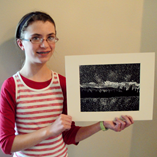What fun we have had this summer! I’m so impressed with the work that the students have done, as they have worked through projects which were new techniques to most.
We did a few landscape paintings for the first project, one being of a Sahara Sunset, and the other being a little more technical with a rainbow in a blue sky over a green, grassy hill. Before we dove into the projects, each student created their own color wheel using only the primary colors: Red, Yellow, Blue, and White and Black to practice tints and shades. This was a good introductory project to the summer course.
The next project we did was a clay figurine. I allowed the students to select their subject matter, but I wanted to help them focus on thinking in 3D, where so many are accustomed to a two-dimensional drawing. It was a stretch for some, but I feel that the figurines turned out better than I had expected.
Last project was print making. We mapped out the image, transported that to a linoleum block, carved out the image, and then inked the image to print on a paper. This was my favorite project because there is always the element of surprise in how the carving is going to turn out. It’s like magic every time!
















